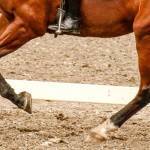Riding Horses on Sand

Concussion is the force transmitted up a horse’s leg each time a hoof hits the ground. Structures in the hoof and leg absorb concussion, but over time, the cumulative effects of concussion can cause lameness, joint damage, and arthritis. Softer surfaces reduce concussion on bones and cartilage, but may throw the stress onto soft tissues instead.
A study in France showed that horses exercising on sand had a lower rate of concussion and vertical loading. Four horses were fitted with instruments that recorded acceleration and ground reaction forces generated with each step. Each horse was then ridden at a trot on firm wet sand, deep wet sand, deep dry sand, and asphalt pavement.
Impact forces were significantly decreased when the horses were worked on the sand surfaces. However, trotting on sand produced markedly different stride dynamics. The horses took shorter, more frequent strides, and propulsive effort was increased on deep wet sand over firm wet sand. In other words, the horses worked harder on the sand surfaces, using more energy than when moving on a firm surface. Staying balanced on a yielding surface could stress muscles, tendons, and ligaments that might not be used as hard when horses work on hard dirt or pavement.








